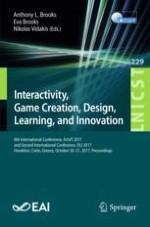2018 | OriginalPaper | Buchkapitel
Blocks as Symbolic Tools for Children’s Playful Collaboration
verfasst von : Cristina Sylla, Eva Brooks, Lisa Tümmler
Erschienen in: Interactivity, Game Creation, Design, Learning, and Innovation
Aktivieren Sie unsere intelligente Suche, um passende Fachinhalte oder Patente zu finden.
Wählen Sie Textabschnitte aus um mit Künstlicher Intelligenz passenden Patente zu finden. powered by
Markieren Sie Textabschnitte, um KI-gestützt weitere passende Inhalte zu finden. powered by
